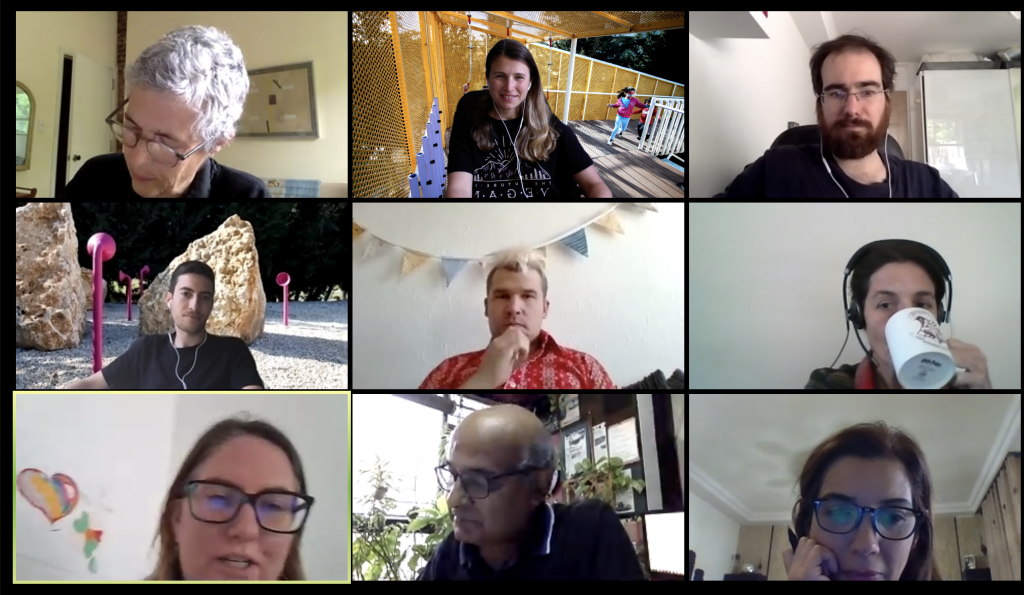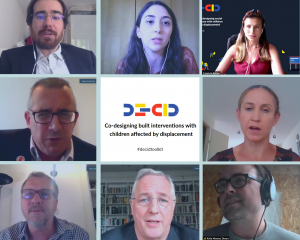On May 6 2020, we invited practitioners with knowledge and experience in the participation of children in displacement to discuss preliminary findings from interviews and share their insights with us. We were very happy to welcome Sheridan Bartlett (Children’s Environments Research Group at CUNY Graduate Center, USA), Emanuela Rizzo (Save the Children Jordan), Sara Candiracci (ARUP International Development, UK), Bobby Beaumont (The Flying Seagull Project, UK), Lady Habchy (UN Habitat Lebanon), and Prasanna Desai (Prasanna Desai Architects, Pune, India).
The key questions and answers are highlighted here:
What do you need to pay attention to when you are working with different groups, like children and adults together? What have you found works well?
– We need to take into account the different levels of literacy and education of children and tailor activities accordingly. When including young children, it is important to involve their caregivers and to have children present, as their carers can learn from observing and playing with them.
– Play is a good starting point to engagement with children across contexts, ages and abilities, which will gain their and their parents’ trust. Open, nature-based spaces can make engagement with children easier than closed spaces.
– Participation is not always seen the same in different contexts, we need to ensure meaningful accessibility, that participation addresses diversity of children and is not just consultation, but truly empowering.
– When working in the context of violence towards children, it is important to have a psychologist present. Talking about space can bring up topics that would not otherwise be addressed/spoken about, such as domestic abuse.
To what extent can children contribute to the building process? What would be the value, the concerns, and the risks?
– There is always a tension between encouraging children to be part of the process in a safe way and avoiding them being exploited for work. Children often want to be involved in the construction and they can be very helpful. While involving children in construction can be unsafe, so can not involving them.
– Safeguarding rules need to be put in place to ensure the protection of children. Use play to safeguard them from health and safety issues.
How do you deal with diversity, power dynamics and equal engagement in participation?
– If not done well, participation risks increasing power relations and inequalities.
– Refugee camps can sometimes be perceived as thriving cities, when there are spaces that look like high streets, but usually only a small percentage of people in camps have access to these spaces.
– Working with children is a nice entry point. You need to make sure that all stakeholders are involved and informed, and communicate well and from the beginning that the project is going to benefit the whole community.
– Example: An early childhood program in Nepal that created a day care centre that became a place where the usual boundaries could be ignored for a while. It didn’t necessarily solve any local problem but it created an alternative opportunity for interaction.
Projects with and/or for children often have pre-defined outputs or other aspects that limit the extent to which participatory sessions with children can actually shape the outcomes. When should participation be refused?
– It is important to consider the context and be ready to change your approach, and to gain children’s trust. Don’t promise anything you can’t deliver.
– Wherever possible, work with transparent budgets.
– Don’t patronise the children but be honest about what kind of space will be created.
What are some of the key personal characteristics of the facilitators of the participatory process with children in built environment projects?
– Understanding the reality on the ground and the community,
– good communication skills,
– ability to create a safe space,
– capacity to listen patiently to children and spend time in the community,
– passion,
– ability to engage different parties as well as children, and
– leadership abilities.
Many thanks to our participants! If you would like to contribute, please get in touch!



